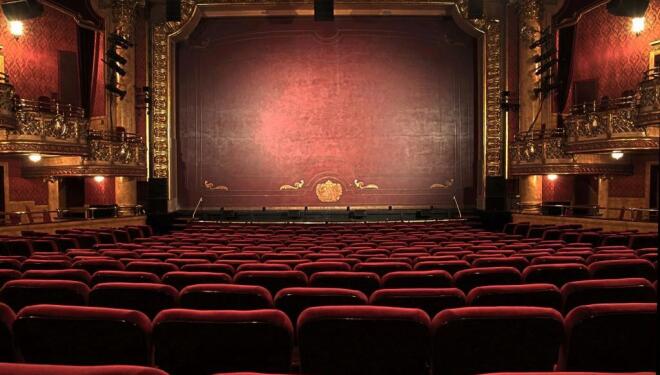Theatre Director Michael Longhurst interview
Rising star director Michael Longhurst tells us about switching from bold new writing to traditional Shakespeare

But Michael Longhurst is a little more measured.
'It's my first Shakespeare ever so it's a big deal for me” the director explains, telling us about his production of The Winter’s Tale at the Sam Wanamaker Playhouse.
It’s not that Longhurst lacks professional experience. His C.V. reads like a who’s who of contemporary theatre’s shining talents: Nick Payne, Penny Skinner, Simon Stephens and Caryl Churchill feature. And from reviving A Number (Nuffield & Young Vic, 2015) in a mirrored box to creating a storm on stage in Linda (Royal Court, 2015), Longhurst’s characteristic conceptual vision is as bold as the stories he stages.
But traditional drama, such as you’d expect at the Globe, was not a part of his repertoire. "I find Classical plays incredibly hard to read on the page,” he tells us.
Then last year, “completely out of the blue” the Globe’s Artistic Director Dominic Dromgoole asked Michael Longhurst to direct a production of Tis Pity She’s a Whore, with no contemporary take, just the traditional Jacobean architecture of the newly-built Sam Wanamaker Playhouse.
“It was a real challenge because a lot of what I do is the conceptual design work and production. Coming in here was tricky because the space is done for you and I’d never done anything in period costume and that made me very nervous"
The nerves were unfounded and critics called it 'coup de théâtre'. Now Longhurst is back at the Wanamaker Playhouse for Dominic Dromgoole’s final season, tackling Shakespeare for the first time.
“I didn’t know The Winter’s Tale very well” he admits. In fact, he agreed to direct the play before he had even finished reading it. “I knew it’s the one with the statue and the one with the bear”.
That exit, pursued by a bear, the statue coming to life, plus a 16 year time lapse, make Shakespeare’s problem play problematic to direct.
“If you’re in a modern production it’s very hard not to do something with video… but if you want to see a bear, go and watch The Revenant” Longhurst jokes.

Micheal Longhurst in rehearsal at the Sam Wanamaker Playhouse
Typically he would approach a play through the spatial possibilities: "I come in from a design point of view. That’s how I get into a play, if I can find a conceptual visual statement for it or a design metaphor, I guess celebrate the theatrical-ness of it."
But the spatial and technical constraints of the Wanamaker’s small candlelit stage enforce the suspension of disbelief demanded by Jacobean audiences. And the tradition makes this production trail-blaizing in its own way. It’s first time modern audiences can see The Winter's Tale performed in the space for which it was written.
"The play just sits perfectly and the journey of light is written in the texture… Shakespeare’s choice of scenes, the locations, how you use lights, you can create a shipwreck by having a single lantern…"
Longhurst's past productions have merged technology and metaphor, from a giant bull on stage in Carmen Disruption, to the simplistic cerebral light flickers of Constellations. But his take on Shakespeare is pared back: “ There’s something very pure about having an actor come out and say, '16 years have passed' and that’s all you have to do”.
While effusive about the magic of the space, and the ‘thrilling’ opportunities offered by candlelight and music, Longhurst is wary about the “temptation to make The Winter’s Tale into a fairytale".
He is more intrigued by the tragi-comic irresolution: “essentially you get Othello for three acts, a tragedy, and then you’re off to the forest for a bit like As You Like It and then it’s a miraculous ending”
His aim is to capture the wondrous ending ‘with a sense of authenticity… you don’t have to send it off into a Cinderella world… we need the redemption and the wonder, not just a neat comic ending.”
Though there's no shortage of tension and irresolution in the new works that Longhurst usually directs, he is used to having the writer on hand to clarify.
“it’s very freeing to have final control of the edit of the play,” he says.
“Ultimately it’s a gift having the writer in the room.” But he goes on to explain how “there’s a lot more pressure when you are working to serve their vision… but I will negotiate, debate, discuss, argue a cause if I think something’s not working” .
But after his first foray into Shakespeare, Longhurst won't be going straight back to his new writing roots. On the day we met it was announced the Longhurst will be directing a blockbuster revival of Amadeus for the National Theatre's Olivier stage in October 2016.
It's the first major revival of Peter Shaffer's 1979 play about Mozart, which was adapted into a hit film. And Longhurst explains that the production will be more than a mere faithful reproduction of the original play.
"Rufus [Norris] is really challenging me to say 'if we are bringing this play back to the Olivier why are we doing it now? What’s going to be different this time?'"
It sounds like this a chance for the director to come up with a fresh new interpretation. "I’ve got a conceptual wave" he hints — and we can't tell if he's being mysterious or genuinely hasn't come up with anything concrete yet.
"I know literally almost nothing about Mozart and in six months I hope I’ll be an expert, so it’s an exciting journey for me to go on".
We certainly look forward to seeing what he comes up with next.
The Winter's Tale is at the Sam Wanamaker Playhouse until 22 April.






